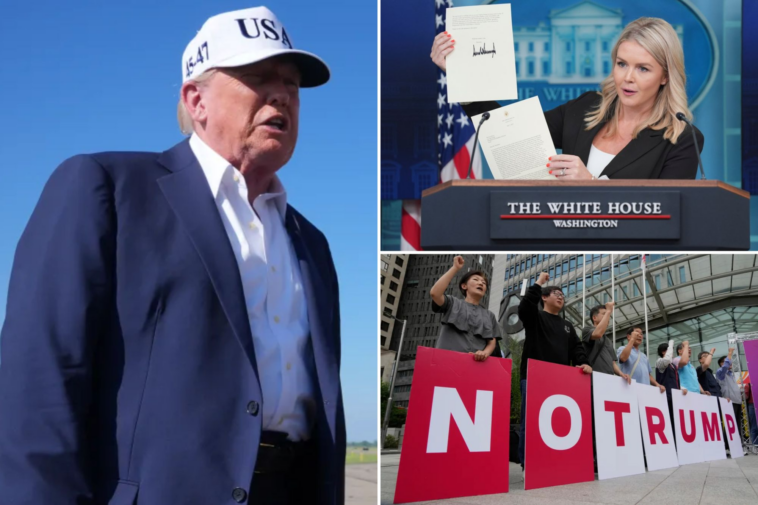WASHINGTON — President Trump told Japan and South Korea Monday that they face a 25% “reciprocal” tariff if they fail to reach a trade deal by Aug. 1 — delaying what had been a July 9 deadline for talks.
Tokyo and Seoul had faced the threat of 24% and 25% tariffs, respectively, before the president fired off his letters — with about a dozen more expected throughout the day.
Also getting letters Monday were Malaysia (facing a 25% rate), Kazakhstan ( also 25%), South Africa (30%), Laos (40%) and Myanmar (40%).
“Please understand that the 25% is far less than what is needed to eliminate the Trade Deficit disparity we have with your Country,” Trump wrote to Japanese Prime Minister Ishiba Shigeru and South Korean President Lee Jae Myung.
“If for any reason you decide to raise your Tariffs,” he added, “then, whatever the number you choose to raise them by, will be added onto the 25% that we charge.”
Japan and South Korea are America’s top trading partners outside of Canada, Mexico, China and the European Union and have had several rounds of preliminary talks with US officials.
Trump, 79, had hinted he would revise some looming rates downward, but his letters indicate leniency may be off the table following a series of positive economic, political and foreign-policy developments.
“They will take the letters seriously because they have taken the president seriously,” White House press secretary Karoline Leavitt said Monday.
“That’s why the president’s phone, I can tell you, rings off the hook from world leaders all the time who are begging him to come to a deal.”
Leavitt added that “this administration is working hard to ensure those deals are in the best interests of the American people and this deal, again, is in the best interest of the American people.”
Only the UK, China and Vietnam so far have reached understandings with the US to avoid the “reciprocal” tariffs.
Trump’s letters caused a midday slump in stock trading after major indices notched record highs last week. The Dow Jones Industrial Average dropped nearly 495 points, or 1.1%, as of 3 p.m. ET.
The Nasdaq fell an additional 1%, while the S&P 500 dipped 0.9%.
Trump first revealed the sweeping “reciprocal” rates for global trading partners after applying 10% duties globally April 2.
Seven days later, he declared a 90-day pause on those rates to pursue negotiations before imposing the levies, roughly correlated by the Council of Economic Advisers to halve current US trade deficits with each country.
Trump threatened Friday to go as high as 70% with some nations holding out on tariff agreements — and warned early Monday the US would hammer nations aligned with the BRICS organization (Brazil, Russia, India, China and South Africa) with a 10% additional hit.
The looming rates apply to countries with which the US has trade deficits. Most countries, including those with which the US has surpluses, already have a new 10% baseline rate, roughly triple the prior average.
The UK trade agreement, if finalized, will keep 10% baseline tariffs on most goods, while exempting most British-made cars, steel and aluminum from 25% levies that had been announced separately.
The US-China arrangement is still being ironed out before Aug. 10 to avoid snapback rates to 145% on the American side and 125% on the Chinese side.
The Vietnam deal includes a baseline 20% tariff rate as well as 40% on goods “transshipped” from China or other countries.
Every morning, the NY POSTcast offers a deep dive into the headlines with the Post’s signature mix of politics, business, pop culture, true crime and everything in between. Subscribe here!
Under the USMCA trade deal from Trump’s first term, goods from Canada and Mexico have evaded higher duties, though 25% tariffs were added on items not previously part of that agreement.
Japan remains one of the few top US trading partners to not reach a preliminary agreement on tariffs — along with the European Union, which currently risks a 50% rate.
“As we get to the smaller countries, we’re pretty much going to keep the tariffs the same,” Trump told reporters Friday.
“They’ll start to pay on Aug. 1. The money will start to come into the United States on Aug. 1 in pretty much all cases.”
Critics have predicted that American consumers will bear the brunt of the attempted trade realignment due to the price of goods surging, while Trump administration officials have touted the benefit of increased Treasury revenue.
As with the agreement with Vietnam, Monday’s letters to Japan and South Korea cautioned that “goods transshipped to evade a higher Tariff will be subject to that higher Tariff.”
“These Tariffs may be modified, upward or downward, depending on our relationship with your Country.”



